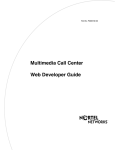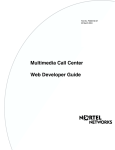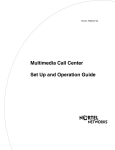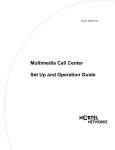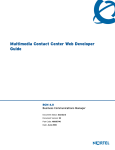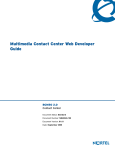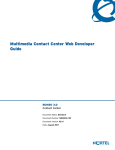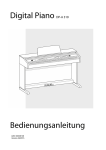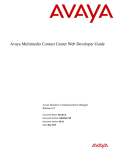Download Avaya Multimedia Call Center User's Manual
Transcript
Return
to Menu
Part No. P0935740 02
Multimedia Call Center
Web Developer Guide
2
Multimedia Call Center Web
Developer Guide
Copyright © 2001 Nortel Networks
All rights reserved. 2001.
The information in this document is subject to change without notice. The statements, configurations, technical data, and
recommendations in this document are believed to be accurate and reliable, but are presented without express or implied
warranty. Users must take full responsibility for their applications of any products specified in this document. The information in
this document is proprietary to Nortel Networks NA Inc.
The software described in this document is furnished under a license agreement and may be used only in accordance with the
terms of that license. The software license agreement is included in this document.
Trademarks
NORTEL NETWORKS is a trademark of Nortel Networks.
Microsoft, MS, MS-DOS, Windows, and Windows NT are registered trademarks of Microsoft Corporation.
All other trademarks and registered trademarks are the property of their respective owners.
P0935740 02
3
Contents
Chapter 1
About Multimedia Call Center web pages . . . . . . . . . . . . . . . . . . . . . . . . . . . 5
Prerequisites for customizing Multimedia Call Center web pages . . . . . . . . . . . . . . . . . 5
Chapter 2
Multimedia Call Center messages . . . . . . . . . . . . . . . . . . . . . . . . . . . . . . . . . 7
About Multimedia Call Center messages . . . . . . . . . . . . . . . . . . . . . . . . . . . . . . . . . . . 7
Multimedia Call Center message templates . . . . . . . . . . . . . . . . . . . . . . . . . . . . . . . . . 7
Call setup page for first-time callers . . . . . . . . . . . . . . . . . . . . . . . . . . . . . . . . . . . . 8
Call setup page for subsequent callers . . . . . . . . . . . . . . . . . . . . . . . . . . . . . . . . . . 9
Voice button unavailable message . . . . . . . . . . . . . . . . . . . . . . . . . . . . . . . . . . . . 10
No agents logged on message . . . . . . . . . . . . . . . . . . . . . . . . . . . . . . . . . . . . . . . 10
Off-hours message . . . . . . . . . . . . . . . . . . . . . . . . . . . . . . . . . . . . . . . . . . . . . . . . 11
Bad calling preferences message . . . . . . . . . . . . . . . . . . . . . . . . . . . . . . . . . . . . 11
.
Choose how to connect message . . . . . . . . . . . . . . . . . . . . . . . . . . . . . . . . . . . . 12
.
Web refresh message . . . . . . . . . . . . . . . . . . . . . . . . . . . . . . . . . . . . . . . . . . . . . . 12
Session completed message . . . . . . . . . . . . . . . . . . . . . . . . . . . . . . . . . . . . . . . 13
.
User busy message . . . . . . . . . . . . . . . . . . . . . . . . . . . . . . . . . . . . . . . . . . . . . . . 13
Server busy message . . . . . . . . . . . . . . . . . . . . . . . . . . . . . . . . . . . . . . . . . . . . . . 13
Make call failed message . . . . . . . . . . . . . . . . . . . . . . . . . . . . . . . . . . . . . . . . . . . 14
Preferences message . . . . . . . . . . . . . . . . . . . . . . . . . . . . . . . . . . . . . . . . . . . . . . 14
Alerting message . . . . . . . . . . . . . . . . . . . . . . . . . . . . . . . . . . . . . . . . . . . . . . . . . 14
No answer message . . . . . . . . . . . . . . . . . . . . . . . . . . . . . . . . . . . . . . . . . . . . . . . 15
Chapter 3
Customizing Multimedia Call Center web pages . . . . . . . . . . . . . . . . . . . . 17
About customizing Multimedia Call Center web pages . . . . . . . . . . . . . . . . . . . . . . . .17
An overview of customizing an off hours page . . . . . . . . . . . . . . . . . . . . . . . .17
Customizing msg.html . . . . . . . . . . . . . . . . . . . . . . . . . . . . . . . . . . . . . . . . . . . . . . 18
Customizing call_setup1.html and call_setup.html . . . . . . . . . . . . . . . . . . . . . . . .18
Customizing off_hours.html . . . . . . . . . . . . . . . . . . . . . . . . . . . . . . . . . . . . . . . . . . 19
Customizing launch_monitor.html . . . . . . . . . . . . . . . . . . . . . . . . . . . . . . . . . . . . 19
.
Customizing Refresh.html . . . . . . . . . . . . . . . . . . . . . . . . . . . . . . . . . . . . . . . . . . . 19
Web page lists . . . . . . . . . . . . . . . . . . . . . . . . . . . . . . . . . . . . . . . . . . . . . . . . . . . . . . . 20
Naming web page lists . . . . . . . . . . . . . . . . . . . . . . . . . . . . . . . . . . . . . . . . . . . . . 20
Uploading web pages . . . . . . . . . . . . . . . . . . . . . . . . . . . . . . . . . . . . . . . . . . . . . . . . . 21
Multimedia Call Center Web Developer Guide
4
Contents
Chapter 4
Using CGI scripts with Multimedia Call Center . . . . . . . . . . . . . . . . . . . . . . 23
About CGI scripts . . . . . . . . . . . . . . . . . . . . . . . . . . . . . . . . . . . . . . . . . . . . . . . . . . . . 23
Restricting caller access to Multimedia Call Center . . . . . . . . . . . . . . . . . . . . . . . 23
Refresher CGI scripts . . . . . . . . . . . . . . . . . . . . . . . . . . . . . . . . . . . . . . . . . . . . . . . . . 24
The call command . . . . . . . . . . . . . . . . . . . . . . . . . . . . . . . . . . . . . . . . . . . . . . . . . . . . 27
How call types use the call command . . . . . . . . . . . . . . . . . . . . . . . . . . . . . . . . . . 27
Agent-centric voice and data call . . . . . . . . . . . . . . . . . . . . . . . . . . . . . . . . . . 27
Data only call . . . . . . . . . . . . . . . . . . . . . . . . . . . . . . . . . . . . . . . . . . . . . . . . . 27
Multimedia Call Center CGI parameters . . . . . . . . . . . . . . . . . . . . . . . . . . . . . . . . . . . 28
Optional Multimedia Call Center CGI parameters . . . . . . . . . . . . . . . . . . . . . . . . . 28
Using call command parameters in HTML forms . . . . . . . . . . . . . . . . . . . . . . . . . 29
Using a URL-encoded hypertext link interface . . . . . . . . . . . . . . . . . . . . . . . . . . . . . . 30
Using voice button with HTML Frames . . . . . . . . . . . . . . . . . . . . . . . . . . . . . . . . . . . . 30
Communicating with Multimedia Call Center agent software . . . . . . . . . . . . . . . . . . . 31
Placing a browser only call to an agent . . . . . . . . . . . . . . . . . . . . . . . . . . . . . . . . . 31
Call preferences - the setup command . . . . . . . . . . . . . . . . . . . . . . . . . . . . . . . . . . . . 32
Bypassing Multimedia Call Center setup information . . . . . . . . . . . . . . . . . . . . . . . . . 33
Multimedia Call Center graphics . . . . . . . . . . . . . . . . . . . . . . . . . . . . . . . . . . . . . . . . . 34
Index . . . . . . . . . . . . . . . . . . . . . . . . . . . . . . . . . . . . . . . . . . . . . . . . . . . . . . . . 35
P0935740 01.2
5
Chapter 1
About Multimedia Call Center web pages
This guide is about how a web developer customizes Multimedia Call Center web pages.
Prerequisites for customizing Multimedia Call Center web
pages
To customize Multimedia Call Center web pages you must understand:
•
•
•
•
Web page development techniques, including using frames and tables
HTML syntax, especially the <FORM> tag
how to access CGI scripts
the host name where the Multimedia Call Center service is installed
Multimedia Call Center uses a client browser window with two frames. The top frame contains an
applet that provides the Multimedia Call Center functionality. The bottom frame displays web
pages, either as a result of performing a Multimedia Call Center operation, or from following a
link from a previous page.
As a web developer, ensure that your site's pages are frame-friendly. Make sure that internal links
or operations do not destroy the Multimedia Call Center frameset. Make sure that external links
(and internal links or operations that cannot preserve the frameset) open in a new browser window.
In this document the server that Multimedia Call Center is installed on is referred to as
“voicebutton.<domain>”
where:
•
•
<domain> is the domain name of the business, for example nortelnetworks.com
“voicebutton” is the hostname of the server within the domain.
The server is usually called “voicebutton”, although any unique hostname within the domain is
acceptable.
The Multimedia Call Center system administrator must provide you with:
•
•
•
the domain name of the Business Communications Manager 2.5 ("voicebutton.<domain>")
Where <domain> is the domain name of the business, for example, NortelNetworks.com or
NortelNetworks.org
the name of the Business Communications Manager 2.5 account
the IDs of the skillsets
Multimedia Call Center Web Developer Guide
6
Chapter 1 About Multimedia Call Center web pages
P0935740 02
7
Chapter 2
Multimedia Call Center messages
About Multimedia Call Center messages
Multimedia Call Center messages are messages that are sent from a business’ web site to
customers, contacts, or surfers that have contacted the business.
These messages assist callers in making contact with the business, give callers choices in the type
of media they use to contact the business, and provide callers with updates about the progress of
their call.
You or the system administrator can:
•
•
customize the default Multimedia Call Center message templates
create lists of web pages that Multimedia Call Center agents push to callers
For information on:
•
•
•
the default Multimedia Call Center messages see “Multimedia Call Center message templates”
on page 7
customizing messages see Customizing web pages
uploading web pages see “Uploading web pages” on page 21
Multimedia Call Center message templates
You can customize the message templates that are included with Multimedia Call Center.
The message templates are on Business Communications Manager 2.5 in:
•
•
C:\Program Files\Nortel Networks\Voice Button\html
C:\Program Files\Nortel Networks\Voice Button\html\adm
Multimedia Call Center Web Developer Guide
8
Chapter 2 Multimedia Call Center messages
Call setup page for first-time callers
First-time callers see this html form when they click the voice button.
CALL_SETUP1.html
P0935740 02
Chapter 2 Multimedia Call Center messages
9
Call setup page for subsequent callers
Subsequent callers see this html form if they click the preferences link. Subsequent callers do not
see this html form if you configure the do_setup parameter so that callers must enter their calling
preferences each time.
CALL_SETUP.html
Multimedia Call Center Web Developer Guide
10
Chapter 2 Multimedia Call Center messages
Voice button unavailable message
Callers see this message if they click the voice button while Business Communications Manager
2.5 is down.
MSG.html
No agents logged on message
This is the message callers see if there are no Multimedia Call Center agents logged on.
MSG.html
P0935740 02
Chapter 2 Multimedia Call Center messages
11
Off-hours message
Callers see this message if they click the voice button outside of business hours. The Call Center
handles the call based on the Night Routing Table steps for the day of the week that the Call Center
Administrator sets up in the Call Center Administration settings of CallPilot Manager.
OFF_HOURS.html
Bad calling preferences message
Callers see this message if the phone number they enter in the call setup page is improperly
formatted, or if Multimedia Call Center does not provide service to their calling area.
MSG.html
Multimedia Call Center Web Developer Guide
12
Chapter 2 Multimedia Call Center messages
Choose how to connect message
Callers see this message if they do not specify their connection preferences in the call setup page.
MSG.html
Web refresh message
Callers see this message while they are waiting for a Multimedia Call Center agent to become
available. You can create variations of this message to assure callers that their call is important, and
all agents are still busy.
MSG.html
P0935740 02
Chapter 2 Multimedia Call Center messages
13
Session completed message
Callers see this message after they click the Hangup button on the Multimedia Call Center caller
interface.
MSG.html
User busy message
Callers see this message if their call cannot be completed because their phone line is busy.
MSG.html
Server busy message
Callers see this message if their call cannot be completed because Business Communications
Manager 2.5 has no available phone lines.
MSG.html
Multimedia Call Center Web Developer Guide
14
Chapter 2 Multimedia Call Center messages
Make call failed message
Callers see this message if their call cannot be connected because there is a problem with the voice
button server.
MSG.html
Preferences message
Callers see this message after they enter their calling preferences in the call setup page.
MSG.html
Alerting message
Callers see this message if the call fails after they click the voice button.
MSG.html
P0935740 02
Chapter 2 Multimedia Call Center messages
15
No answer message
Callers see this message if they do not answer their phone.
MSG.html
Multimedia Call Center Web Developer Guide
16
Chapter 2 Multimedia Call Center messages
P0935740 02
17
Chapter 3
Customizing Multimedia Call Center web pages
About customizing Multimedia Call Center web pages
You can customize web pages and upload them to Business Communications Manager 2.5.
You can customize the default Multimedia Call Center web pages or create your own.
Note: Do not directly edit web pages.
Do not change the location of the Multimedia Call Center default files on Business
Communications Manager 2.5.
To customize web pages
1
In your browser, open the URL that contains the default file you want to customize.
2
View the source code for the web page:
•
•
if you use Internet Explorer, on the View menu click Source.
The source code for the page appears in a Notepad window.
if you use Netscape Navigator, on the View menu click View Source.
The source code for the page appears in a Netscape Navigator window.
Copy and paste the code to a Notepad window.
3
On the File menu click Save As.
The Save As dialog box appears.
4
Save the file to a directory on your computer.
Do not change the name of the file.
5
Customize the file.
6
Upload the customized files to the Business Communications Manager 2.5 using the
procedure in “Uploading web pages” on page 21.
An overview of customizing an off hours page
This is an example of customizing an off_hours.html file for the ABC Computer Company:
1
Download the off_hours.html template from Business Communications Manager 2.5 to your
desktop using your browser's View Source functionality.
2
Customize the off_hours.html file.
3
Save the new customized file in your local directory as acme_hours.html.
4
Log on to Business Communications Manager 2.5 using the ABC Computer Company name
and password.
5
Upload the file.
Multimedia Call Center Web Developer Guide
18
Chapter 3 Customizing Multimedia Call Center web pages
Customizing msg.html
If you customize msg.html, do not insert anything above or in front of the first line. The first line is
processed by the CGI script and contains the response code from Business Communications
Manager 2.5. The Multimedia Call Center agent application parses this line to determine how to
handle error cases.
Do not change the names of any of the error codes and their body of text that are displayed to the
user. You can put tags such as <FONT> tags around the text to specify a certain style, but do not
change the error code names or the structure of the comments. These blocks of text become
uncommented by the CGI script when they are displayed to the user if an error occurs.
Due to problems with Netscape 3, Netscape 6.0 and Internet Explorer 5.5 refreshing Java applets
when they are contained within an HTML table cell, do not put the <!--MONITOR... block of code
inside an HTML table.
Do not alter the line <xxMSGxx>.
You can change the line: <H3><xxSIGNATURExx></H3>.
This line is substituted for the value of the signature parameter contained in the voiceweb.ini file.
By default, this substitutes to <H3>NORTEL Business Communications Manager</H3>. You can
use the <xxSIGNATURExx> variable anywhere on the page. You can define what the server
displays by changing the value of the signature parameter in the C:\Program Files\Nortel
Networks\voiceweb\system\voiceweb.ini file.
You can alter the style elements of the page, such as colors and fonts, and the layout of the page.
The page uses a table to control the page width. But the point regarding the problem with Netscape
3 refreshing Java applets in a table applies.
You can remove the links on the bottom of this page or add different ones. It is recommended that
you maintain a link to the preferences page.
Customizing call_setup1.html and call_setup.html
You can customize these pages but you must maintain the syntax of the HTML FORM that is used.
The CGI script uses the variables:
•
•
•
•
•
•
•
xxRETURNURLxx
xxCALLERxx
xxMONITORxx
xxSKILLSETxx
xxDNxx
xxDIALFORMAT
xxIPUSERxx
to substitute the values passed from the web page to the server and parameters obtained from the
caller's http cookies. Do not change or delete these variables.
P0935740 02
Chapter 3 Customizing Multimedia Call Center web pages
19
Customizing off_hours.html
You can modify the html text as appropriate. For example, "All of our offices are now closed.
Please call back during the hours of 9:00 am and 5:00 pm Eastern time. In the case of an
emergency please dial 613-555-1234. Thank you."
Customizing launch_monitor.html
Launch_monitor.html is the page used by msg.html to launch the Multimedia Call Center caller
monitor applet within a frame.
Do not change the applet tag or the PARAM tags in the default launch_monitor.html page. The
Multimedia Call Center CGI script gives them the appropriate values to ensure that the caller
monitor applet works correctly.
You can modify the colors used in the caller monitor applet by setting additional parameters in the
launch_monitor.html file. You can set parameters by adding <PARAM> tags that specify
foreground and background colors:
<PARAM NAME=param_name VALUE=param_value>
These lines must be placed in the list with the other PARAM tags. Valid param_names are:
•
•
•
•
foreground
background
buttonforeground
buttonbackground
Valid values of these parameters are: red, blue, yellow, green, white, cyan, magenta, orange, gray,
and black. The default values are black for the foreground, oyster gray for the background, black
for the button foreground, and oyster gray for the button background.
You can alter the style of launch_monitor.html, but the colors and fonts must match the ones used
in the caller monitor applet. Launch_monitor.html is used within a frame defined in the msg.html
file. If you want to put more content on launch_monitor.html page, the frame must be resized by
customizing the msg.html page.
Customizing Refresh.html
Edit only the text between the xxA<#>xx tags, where <#> is the number of the Call Center
greeting. Do not edit or delete the xxA<#>xx tags.
For all the Call Center greeting number used in the Call Center skillset routing table, make sure
that the text in the corresponding tags in this file contain suitable information. Each tag in the
refresh.html file is intended to correspond to a particular Call Center greeting. If a corresponding
tag and greeting are used, they must have similar content.
You can insert information such as text, image and animations between the xxA<#>xx tags.
Multimedia Call Center Web Developer Guide
20
Chapter 3 Customizing Multimedia Call Center web pages
Web page lists
You can create lists of web pages that agents can push to callers. A list can include up to 100 web
pages. You must upload web page lists to Business Communications Manager 2.5.
For information on naming web page lists see “Naming web page lists” on page 20.
For information on uploading web page lists see “Uploading web pages” on page 21.
Naming web page lists
You can create a list of web pages that agents can push pages to customers from. Each web page
list is stored in a text file. To create or modify a web page list file, use a text editor such as
Notepad.
Name the web page list file according to this format:
•
•
name: a name for the URL (Web Page)
url: a valid URL (Web Page address)
For example:
•
•
name: Nortel Networks Home page
url: http://www.nortelnetworks.com/
and
•
•
name: Internet Voice Button home page
url: http://www.nortelnetworks.com/voicebutton
P0935740 02
Chapter 3 Customizing Multimedia Call Center web pages
21
Uploading web pages
You can upload customized web pages from a computer to Business Communications Manager
2.5.
To upload customized files
1
Point your web browser to the URL
http://voicebutton.<domain>:6800
where <domain> is the domain name of Business Communications Manager 2.5.
The Business Communications Manager 2.5 Unified Manager screen appears.
2
Click the Configure button.
The Login screen appears.
3
In the User ID box type your user ID.
The default user ID is supervisor.
4
In the Password box type your password.
The default password is visor.
5
Click the Login button.
The Unified Manager screen appears.
6
Click the Services key.
7
Click the Voice Button heading.
8
On the Tools menu click Voice Button Admin.
The Enter Network Password dialog box appears.
9
In the User Name box type your user name.
The default user name is supervisor.
10 In the Password box type your password.
The default password is visor.
Multimedia Call Center Web Developer Guide
22
Chapter 3 Customizing Multimedia Call Center web pages
11 Click the OK button.
The System Administration page appears.
12 Under the Customize heading:
•
click the Browse button to browse for files on your desktop that you want to upload and
click the Upload button
or
•
if you want to view a list of the files that are uploaded, click the List Files button to
generate a list of the files that are uploaded to Business Communications Manager 2.5.
The list appears in a new browser page
or
if you want to customize msg.html, call_setup.html, call_setup1.html, off_hours.html,
launch_monitor.html or refresh.html:
— In the Remote File name box enter the name of the file you want to customize, for
example, off_hours.html.
— Click the Browse button and browse to the location of the file you customized, for
example, acme_hours.html.
— Click the Upload button.
P0935740 02
23
Chapter 4
Using CGI scripts with Multimedia Call Center
This chapter is about CGI scripts and how to use them with Multimedia Call Center.
About CGI scripts
The Multimedia Call Center CGI script lets you use a variety of web page layout styles and user
interfaces. With CGI scripts you can design web page layout styles and interfaces for the
customer’s web site.
Callers can access Multimedia Call Center:
•
•
from an HTML Form
from a hypertext link to a URL
Both these methods of accessing Multimedia Call Center use one web interface that executes the
Multimedia Call Center CGI script: http://voicebutton.<domain>:6800/ivb-cgi-bin/vb.exe
where <domain> is the domain name of the business, for example, NortelNetworks.com or
NortelNetworks.org.
Restricting caller access to Multimedia Call Center
If your customer wants to restrict who is able to click the Multimedia Call Center html icon, you
can put the Multimedia Call Center access page behind a CGI Perl log on page that asks for user
identification and a password. By creating a log on page in front of the Multimedia Call Center
page your customer can limit who is able to click the Multimedia Call Center icon.
Multimedia Call Center Web Developer Guide
24
Chapter 4 Using CGI scripts with Multimedia Call Center
Refresher CGI scripts
Store CGI refresher scripts in the Multimedia Call Center directory structure using the logical
Internet path: http://voicebutton.<domain>:6800/ivb-cgi-bin/refresh.pl
The "pl" extension refers to a Perl CGI script. This is the default file and must be provided by the
user.
Note: The logical path "http://voicebutton.<domain>:6800/ivb-cgi-bin/" exists on all
Business Communications Manager 2.5s, where <domain> is the domain name of the
business.
A single script can handle all the announcements by containing a case statement to separate the
announcement numbers into the proper HTML display. What follows are a list of the parameters
that are sent to the Perl script. All these parameters are optional.
•
•
•
•
•
•
•
UCID is the Unique Call Identifier
UQID is the Unique Skillset Identifier
AID is the Announcement ID from CC
AIQ is the Agents in the skillset
CIQ is the Calls in skillset
ANWTIQ is the Anticipated wait time in skillset (hh:mm)
LWTIQ is the Longest wait time in skillset (hh:mm)
You must write the Perl script to handle the absence of all data.
Here is an example CGI script that uses these parameters taken from refresh.pl. This script is the
default script on the initial installation of the program. You can customize this script at the request
of your customer.
#!C:\Tivoli\lcf\perl.exe
sub get_buffer
{
local(*buffer) = @_;
if (!defined($ENV{'QUERY_STRING'}) || ($ENV{'QUERY_STRING'} eq ""))
{ read(STDIN, $buffer, $ENV{'CONTENT_LENGTH'}); }
else
{ $buffer = $ENV{'QUERY_STRING'}; }
}
# --------------------------------------------------------sub decode_buffer
{
local ($pair, @pairs, $value, $name);
P0935740 02
Chapter 4 Using CGI scripts with Multimedia Call Center
25
local (*FORM, *buffer) = @_;
foreach (keys %FORM){delete $FORM{$_};}
@pairs = split(/&/, $buffer);
foreach $pair (@pairs)
{
($name, $value) = split(/=/, $pair);
$value = &decode_value($value);
$value =~ s/<!--(.|\n)*-->//g;
$value =~ s/<([^>]|\n)*>//g;
$value =~ s/[^\w \n\.,()-:\/&?=#\*\\]//eg;
$FORM{$name} = $value;
}
}
# --------------------------------------------------------sub decode_value
{
local ($value) = @_;
$value =~ tr/+/ /;
$value =~ s/%([a-fA-F0-9][a-fA-F0-9])/pack("C", hex($1))/eg;
return($value);
}
open(LOG,">data.log");
&get_buffer (*buffer);
print LOG $buffer;
&decode_buffer (*FORM, *buffer);
$UCID= $FORM{'UCID'} ? $FORM{'UCID'} : "unknown";
$UQID= $FORM{'UQID'} ? $FORM{'UQID'} : "unknown";
$AID= $FORM{'AID'} ? $FORM{'AID'} : "unknown";
$AIQ= $FORM{'AIQ'} ? $FORM{'AIQ'} : "unknown";
$CIQ= $FORM{'CIQ'} ? $FORM{'CIQ'} : "unknown";
$PIQ= $FORM{'PIQ'} ? $FORM{'PIQ'} : "unknown";
$ANWTIQ= $FORM{'ANWTIQ'} ? $FORM{'ANWTIQ'} : "unknown";
$AVWTIQ= $FORM{'AVWTIQ'} ? $FORM{'AVWTIQ'} : "unknown";
$LWTIQ= $FORM{'LWTIQ'} ? $FORM{'LWTIQ'} : "unknown";
print "Content-type: text/html\n\n";
open(TEMPLATE,"..\\html\\refresh_tpl.html");
read(TEMPLATE,$buff,64000);
close(TEMPLATE);
Different web refresh messages to appear for different
Multimedia Call Center Web Developer Guide
26
Chapter 4 Using CGI scripts with Multimedia Call Center
# Announcement IDs (which correspond to recording greetings in Call Center).
$MAX_RECORDED_ANNOUNCEMENTS = 150;
if ( $AID > 0 && $AID <= $MAX_RECORDED_ANNOUNCEMENTS )
{
$annoucement_lead = "<!--xxA" . $AID . "xx";
$annoucement_end = "xxA" . $AID . "xx-->";
$buff =~ s/$annoucement_lead//;
$buff =~ s/$annoucement_end//;
}
else
{
$buff =~ s/<!--xxDEFAULTxx//;
$buff =~ s/xxDEFAULTxx-->//;
}
$buff =~ s/xxIPADDRESSxx/$system_ip/;
$buff =~ s/xxCALLIDxx/$callId/;
$buff =~ s/xxIPUSERxx/$user_ip/;
$buff =~ s/xxCALLMETHODxx/$callMethod/;
$buff =~ s/xxCALLINGNUMxx/$callingNum/;
$buff =~ s/xxxUSERMSGxxx/$usermsg/;
$buff =~ s/xxAGENTCOMMxx/$agentcomm/;
$buff =~ s/xxUCIDxx/$UCID/;
$buff =~ s/xxUQIDxx/$UQID/;
$buff =~ s/xxAIDxx/$AID/;
$buff =~ s/xxAIQxx/$AIQ/;
$buff =~ s/xxCIQxx/$CIQ/;
$buff =~ s/xxPIQxx/$PIQ/;
$buff =~ s/xxANWTIQxx/$ANWTIQ/;
$buff =~ s/xxAVWTIQxx/$AVWTIQ/;
$buff =~ s/xxLWTIQxx/$LWTIQ/;
print $buff;
print "\n";
This script outputs the values of these parameters the to the refresh.html web page on the Business
Communications Manager server.
For information on how to upload the customized refresh.pl file to the Business Communications
Manager server refer to “Uploading web pages” on page 21.
P0935740 02
Chapter 4 Using CGI scripts with Multimedia Call Center
27
The call command
The Multimedia Call Center CGI script executes commands in the Multimedia Call Center system.
Several commands are available. This section covers the "call" command, which places a
phone-to-phone call between two parties. All of the web interfaces used to place a PSTN voice call
use the call command.To place a data exchange only call, see “Placing a browser only call to an
agent” on page 31.
How call types use the call command
Agent-centric voice and data call
This call uses a PSTN voice connection. This means a caller clicks a voice button icon with the
parameter "cmd=call".
Data only call
A data only call occurs if a caller clicks a voice button HTML icon with the parameter
"cmd=chat". The caller does not want to communicate using the PSTN and wants to be connected
in text chat mode only.
Multimedia Call Center Web Developer Guide
28
Chapter 4 Using CGI scripts with Multimedia Call Center
Multimedia Call Center CGI parameters
Three fundamental parameters are passed to the Multimedia Call Center CGI script during call
setup:
•
cmd - specifies the command to be executed in the script. This must be equal to "call" to place
a PSTN voice call, or “chat” to place a browser-only call
•
group - specifies the skillset to be called. Contact your company's Multimedia Call Center
administrator for the IDs of the skillsets that accept calls for your company. In Nortel
Networks Call Center Professional, the ID range is 1-50. For example, group = skillset 01.
Optional Multimedia Call Center CGI parameters
These optional parameters can be passed to the Multimedia Call Center CGI script:
•
return_url: specifies the URL of the web page that is displayed when the CGI script completes
the call setup. If you do not specify a URL, the browser defaults to the referring URL.
•
monitor: can be turned to on or off. The default value is off. This is a mandatory parameter. Set
this parameter to on so that the agent and caller monitors function.
•
dn: specifies the dialing number to be called, also called the directory number.
•
do_setup: can be equal to on or off. The default value is off. If set to on, the Multimedia Call
Center CGI script displays the Multimedia Call Center call setup page to prompt the caller for
their calling preferences.
Multimedia Call Center uses HTTP cookies to store user preferences such as type of call to be
made and whether to use a delay before making a call. You can override these preferences with
additional parameters to the call command.
P0935740 02
Chapter 4 Using CGI scripts with Multimedia Call Center
29
Using call command parameters in HTML forms
You can use HTML forms to obtain and pass the parameters and values of the Multimedia Call
Center CGI script's "call" command. See section “Multimedia Call Center CGI parameters” on
page 28 and “Optional Multimedia Call Center CGI parameters” on page 28 for a list of the valid
parameters.
The following examples show how to use the call command parameters in HTML forms interfaces:
This example displays an icon on the page which, when clicked by the caller, causes a call to be
placed between the caller and the agent.
FORM action="http://voicebutton.<domain>:6800/ivb-cgi-bin/vb.exe"
method="POST">
<INPUT TYPE="hidden" NAME="cmd" VALUE="call">
<INPUT TYPE="hidden" NAME="group" VALUE="skset01">
<INPUT TYPE="hidden" NAME="return_url"
VALUE="http://www.caller.com/thanks_for_calling_us.html">
<INPUT TYPE="image" ALIGN=MIDDLE SRC="call_us_button.gif"
BORDER=0>
</FORM>
This example displays a list of skillsets to be called.
<FORM ACTION="http://voicebutton.<domain>:6800/ivb-cgi-bin/vb.exe"
METHOD="POST">
<INPUT TYPE="hidden" NAME="cmd" VALUE="call">
<SELECT NAME="group">
<OPTION VALUE="skset01" SELECTED>Sales
<OPTION VALUE="skset02">Technical Support<OPTION
VALUE="skset03">Tracking Orders
</SELECT>
<INPUT TYPE="submit" VALUE="Call us now">
</FORM>
Multimedia Call Center Web Developer Guide
30
Chapter 4 Using CGI scripts with Multimedia Call Center
Using a URL-encoded hypertext link interface
The simplest way to include the voice button on a web page is to encode a call to the Multimedia
Call Center CGI script within a hypertext link. Use this type of interface if you want callers to click
an HTML link to place a call.
The following HTML code is an example of a URL-encoded hypertext interface:
<A HREF="http://voicebutton.<domain>:6800/
ivb-cgi-bin/vb.exe?cmd=call&skillset=1">
Click here to call our sales department</A>
Click here to call our sales department
When you encode the call to the CGI script from within a hypertext link:
•
•
separate the options from the CGI command with a '?' character
separate each parameter with a '&' character
Using voice button with HTML Frames
Since the Multimedia Call Center CGI script can return with a new page to be loaded in the
browser (such as the caller setup preferences page or the caller monitor applet page), use the
TARGET parameter in the <FORM> or <A HREF=...> tags if you use these within an HTML
frame. This ensures that the page that appears when the caller clicks the voice button appears in a
full web browser window. If you do not specify the TARGET parameter the web page can appear
in a small frame without functional scroll bars. This can render the caller setup page useless.
The following example shows the use of the TARGET parameter:
<FORM action="http://voicebutton.<domain>:6800/ivb-cgi-bin/vb.exe" method="POST"
TARGET="_VB">
<INPUT TYPE="hidden" NAME="cmd"VALUE="call">
<INPUT TYPE="hidden" NAME="skillset"VALUE="1">
<INPUT TYPE="image" ALIGN=MIDDLE SRC="call_us_button.gif" BORDER=0>
</FORM>\
P0935740 02
Chapter 4 Using CGI scripts with Multimedia Call Center
31
Communicating with Multimedia Call Center agent software
The following HTML code shows how to use the caller monitor applet using a URL-encoded
hypertext interface:
<A HREF="http://voicebutton.<domain>:6800/
ivb-cgi-bin/vb.exe?
cmd=call&skillset=1&monitor=on">
Click here to call a sales person</A>
Click here to call a sales person
When the caller clicks the link, the Multimedia Call Center caller interface appears in their
browser.
Placing a browser only call to an agent
When an agent is on a call with a caller (for example, an agent who calls a caller before any
Multimedia Call Center interface is initiated), the agent and caller can establish a Multimedia Call
Center browser only call. With a browser only call the agent and the caller can share information
using the URL push and text chat features of the Multimedia Call Center agent and caller
interfaces.
The following HTML code is an example of a data exchange only call type using a URL-encoded
hypertext interface:
<A HREF="http://voicebutton.<domain>:6800/
ivb-cgi-bin/vb.exe?
cmd=chat&skillset=1">
Click here to communicate over the Internet with a sales
person</A>
Click here to communicate over
the Internet with a sales person
Note that "cmd" is equal to "chat" and not "call." By using this command, no voice call is
established between the caller and agent and no call setup preferences are needed.
Multimedia Call Center Web Developer Guide
32
Chapter 4 Using CGI scripts with Multimedia Call Center
Call preferences - the setup command
Multimedia Call Center uses HTTP cookies to store information about the caller's call preferences.
The call preferences are:
•
whether to connect the call to the caller using PSTN voice and browser or browser only.
If the caller wants to connect with PSTN voice and browser, the dialing number of the caller is
specified. If the caller wants to connect using only a browser, nothing needs to be specified.
When first-time callers click the voice button icon, the “Call setup page for first-time callers” on
page 8 appears. First-time callers specify their preferences for how to place the call.
Multimedia Call Center obtains the call preferences for subsequent callers from the HTTP cookie
stored with their browser as a result of the first time call. You can include a link to the Multimedia
Call Center setup command on the web page so the caller can reconfigure their preferences.
The following HTML code is an example of including a link to call setup preferences:
<A HREF="http://voicebutton.<domain>:6800/
ivb-cgi-bin/vb.exe?cmd=setup">
Configure your Multimedia Call Center preferences.
</A>
Configure your Multimedia Call Center
preferences
“CALL_SETUP.html” on page 9 shows the Multimedia Call Center preferences page for
subsequent callers if the “do_setup” parameter is specified. If “do_setup”=off, include a link to the
subsequent caller setup page on the HTML page.
The Multimedia Call Center call setup pages for first time callers and subsequent callers are
customizable. See “About customizing Multimedia Call Center web pages” on page 17 for more
information. You can prompt callers each time for their calling preferences. You can prompt callers
each time by specifying the do_setup=on parameter to the Multimedia Call Center CGI script.
The following HTML code is an example of how to use the do_setup parameter in a URL-encoded
hypertext interface:
<A HREF="http://voicebutton.<domain>:6800/
ivb-cgi-bin/vb.exe?
cmd=call&skillset=1&do_setup=on">
Click here to call our sales department</A>
P0935740 02
Click here to call our sales department
Chapter 4 Using CGI scripts with Multimedia Call Center
33
Bypassing Multimedia Call Center setup information
You can bypass the Multimedia Call Center call setup procedure for Multimedia Call Center
callers. You do this by specifying the necessary preference values in the HTML form interface.
The caller preference parameters are:
•
dn_user: the caller's phone number to call when placing a PSTN-based call
•
usermsg: a user message that is passed to Business Communications Manager 2.5 and then is
passed to a Multimedia Call Center agent. This parameter represents the name of the person
making the call. This is a mandatory parameter. The default templates for callsetup.html and
callsetup_l.html include a field for the caller's name. For information on customizing
Multimedia Call Center web pages refer to “About customizing Multimedia Call Center web
pages” on page 17.
The following HTML code lets the caller enter preferences as part of a form interface where voice
button is used:
<FORM ACTION="http://voicebutton.<domain>:6800/
ivb-cgi-bin/vb.exe" METHOD="POST">
<INPUT TYPE="hidden" NAME="cmd" VALUE="call">
<INPUT TYPE="hidden" NAME="group"
VALUE="skset01">
Step 1: Configure how the call is to be placed:
<BR>
<UL>
<LI>Regular Phone:
<INPUT CHECKED TYPE="RADIO" NAME="dn_or_ip"
VALUE="dn">
<LI>Your phone number:
<INPUT TYPE="text" NAME="dn_user" SIZE=23
VALUE=""><BR>
</UL>
Step 2:
<INPUT TYPE="submit" VALUE="Click here to call us
now">
</FORM>
Multimedia Call Center Web Developer Guide
34
Chapter 4 Using CGI scripts with Multimedia Call Center
Multimedia Call Center graphics
You can design web pages that include these Multimedia Call Center graphics.
nortel.gif
vb_logo.jpg
vblogo3.gif
Welcomebanner3.gif
P0935740 02
35
Index
C
O
Call_setup1.html
customizing 18
Off hours message
customizing 17
CGI scripts 5
about 23
Off_hours.html
customizing 19
Customizing
call_setup.html 18
call_setup1.html 18
launch_monitor.html 19
msg.html 18
off_hours.html 19
P
Prerequisites 5
S
F
Skillset
IDs 5
FORM tag 5
U
H
Uploading files 21
HTML syntax
FORM tag 5
W
L
Web page lists
about 20
naming 20
Launch_monitor.html
customizing 19
M
Web pages
customizing 17
customizing, example of 17
Message
first-time callers 8
template locations 7
Messages
alerting 14
busy phone line 13
call preferences improperly formatted 11
call setup 8, 9
choose how to connect 12
no agents 10
no answer 15
no available phone lines 13
off-hours 11
preferences saved 14
server busy 13
server down 10, 14
session completed 13
subsequent callers 9
user busy 13
waiting in queue 14
web refresh 12
Msg.html
customizing 18
Multimedia Call Center Web Developer Guide



































